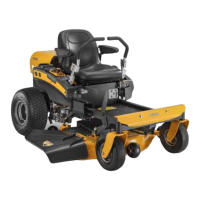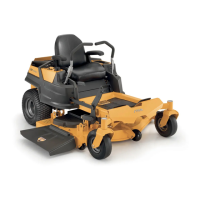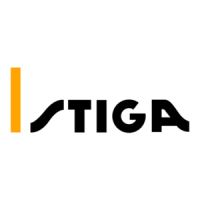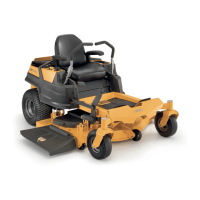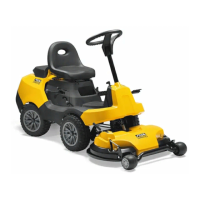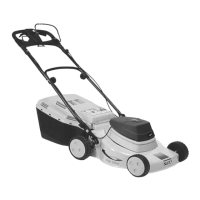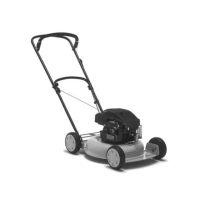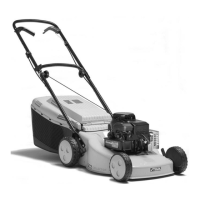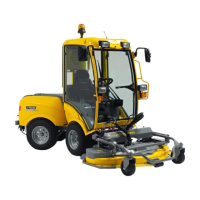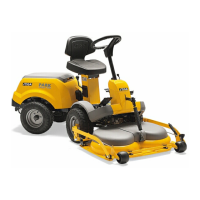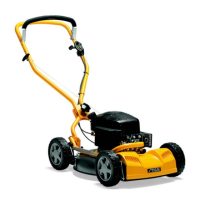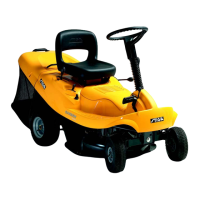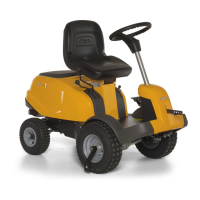2 - Servicing Recommendations Page: 8 2.1.2 Engine Identification Describes how the engine's serial number uniquely identifies its specific product and technical specifications.
2.2 Equipment Required Lists the basic and special tools necessary for servicing operations, including specific screwing and torque tools.
2.2.1 Basic Equipment Mentions standard tools and the benefit of a lifting platform for performing interventions in the machine's lower area.
2.2.2 Special Equipment Recommends using a measuring instrument or extensible abutments to facilitate checking the alignment of the blades.
2.3.1 Machine Transportation Advises on properly securing the machine chassis to transport vehicles and avoiding fastening to easily damaged parts.
2.3.2 Front Lifting Describes the procedure for safely lifting the front of the machine using a jack and stands to access components.
2.3.3 Rear Lifting Explains how to safely lift the rear of the machine using wedges, a jack, and stands for maintenance access.
2.4 Maintenance Covers criteria for performing maintenance and outlines detailed routine maintenance schedules for regular upkeep.
2.4.3 Control of Safety Devices Stresses the importance of maintaining safety systems, including electric devices and safety labels, in efficient working order.
7 - Electrical System Page: 40 7.1 Troubleshooting Offers guidance for diagnosing and resolving common problems within the machine's electrical system.
7.1.3 Equipment Lists specialized tools and consumable materials required for performing electrical repair work.
7.2.1 Wiring Presents the cabling layout and arrangement of electrical utilities with a comprehensive wiring diagram.
7.2.2 Battery Covers battery removal, installation, inspection, cleaning, maintenance, and recharging procedures.
7.2.3 Switches Explains the operation of normally open and closed switches and provides methods for testing their functionality.
7.2.4 Ignition Switch Details the functions of the three-position ignition switch (OFF, RUN, START) and how to test its continuity.
7.2.5 Relays and Solenoids Explains the magnetic principles behind relays and solenoids and their operation in electrical circuits.
7.2.6 Fuses Describes the role of fuses in protecting circuits from overloads and the correct procedure for replacement.
7.3 Functional Checks Guides on performing functional checks of the electrical system in various operating modes and ignition key positions.
7.3.1 General System Checks Outlines essential checks for switches, transmission, parking brake, and battery voltage in different ignition states.
2 - Servicing Recommendations Page: 8 2.1.2 Engine Identification Describes how the engine's serial number uniquely identifies its specific product and technical specifications.
2.2 Equipment Required Lists the basic and special tools necessary for servicing operations, including specific screwing and torque tools.
2.2.1 Basic Equipment Mentions standard tools and the benefit of a lifting platform for performing interventions in the machine's lower area.
2.2.2 Special Equipment Recommends using a measuring instrument or extensible abutments to facilitate checking the alignment of the blades.
2.3.1 Machine Transportation Advises on properly securing the machine chassis to transport vehicles and avoiding fastening to easily damaged parts.
2.3.2 Front Lifting Describes the procedure for safely lifting the front of the machine using a jack and stands to access components.
2.3.3 Rear Lifting Explains how to safely lift the rear of the machine using wedges, a jack, and stands for maintenance access.
2.4 Maintenance Covers criteria for performing maintenance and outlines detailed routine maintenance schedules for regular upkeep.
2.4.3 Control of Safety Devices Stresses the importance of maintaining safety systems, including electric devices and safety labels, in efficient working order.
7 - Electrical System Page: 40 7.1 Troubleshooting Offers guidance for diagnosing and resolving common problems within the machine's electrical system.
7.1.3 Equipment Lists specialized tools and consumable materials required for performing electrical repair work.
7.2.1 Wiring Presents the cabling layout and arrangement of electrical utilities with a comprehensive wiring diagram.
7.2.2 Battery Covers battery removal, installation, inspection, cleaning, maintenance, and recharging procedures.
7.2.3 Switches Explains the operation of normally open and closed switches and provides methods for testing their functionality.
7.2.4 Ignition Switch Details the functions of the three-position ignition switch (OFF, RUN, START) and how to test its continuity.
7.2.5 Relays and Solenoids Explains the magnetic principles behind relays and solenoids and their operation in electrical circuits.
7.2.6 Fuses Describes the role of fuses in protecting circuits from overloads and the correct procedure for replacement.
7.3 Functional Checks Guides on performing functional checks of the electrical system in various operating modes and ignition key positions.
7.3.1 General System Checks Outlines essential checks for switches, transmission, parking brake, and battery voltage in different ignition states.
